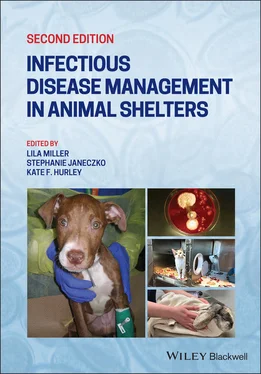This scenario is not at all uncommon in shelters. If accurate (sensitive and specific) pre‐mortem tests are available and results are consistent in affected animals, a cause for increased morbidity and mortality is comfortably determined. However, there are many reasons (e.g. less sensitive test, unusual presentation for a disease, unusual behavior of the disease in a population, non‐responsive to treatment for that disease) a shelter might seek additional information about a disease. In this case, although feces from one cat was positive for the presence of feline panleukopenia virus, the disease seemed to be occurring in the face of vaccination and isolation and was occurring in animals less commonly associated with the suspected disease (older animals).
What should they do? Staff are understandably very busy and need to efficiently diagnose the problem. The tests have been somewhat equivocal and doing full necropsies on each of these animals would likely be very time‐consuming; moreover, they are not sure the gross exam will be helpful since they are not exactly sure what they are seeing.
In a shelter (herd) situation, it is sometimes practical, sufficient, and time‐efficient to ask a more specific (limited) question about disease or death of an animal. Gastrointestinal and respiratory diseases, in particular, are frequent problems in shelters. To ask a more limited question of a necropsy means that the necropsy itself can be simplified. Necropsy samples can be the best samples to definitively diagnose a cause of disease, and proper necropsy sampling in a sentinel case or an infectious outbreak will save other animals.
5.5.1 Sampling a Carcass, General Considerations
The success of infectious disease diagnosis depends largely on the quality of the specimen and the conditions under which the specimen is transported and stored before it is processed in the laboratory. It would be naive to generalize; depending on the suspected agent and the test, the optimum sample and optimum conditions for stabilization during transport are variable. For example, if a bacterial agent is suspected, freezing the specimen could compromise future culture; however, DNA would remain intact and a PCR test relying on extracted bacterial DNA would be unaffected. Some viruses, on the other hand, can withstand freezing, especially if samples are stored in the proper media. There are specific transport media that stabilize viruses and prevent bacterial overgrowth. What this means, of course, is that if the cause of the disease is completely open and multiple tests are going to be performed, multiple types of samples are necessary. Collection is simpler if a certain agent is highly suspect, or if a single agent needs to be ruled in or out.
Because gastrointestinal disease and respiratory disease are the most common infectious diseases associated with morbidity and mortality in the shelter environment, the following section is devoted to the sampling of a cadaver in these types of outbreaks.
5.5.2 Necropsy and Sampling for Gastrointestinal Disease
The following sample collection would be a good starting point for sampling any enteric disease (diarrhea and/or vomiting) of unknown origin in both dogs and cats. While causes of diarrhea can be remote from the gastrointestinal system (heat shock, for example), MOST contagious or toxin‐associated GI disease results from a direct attack on the gastrointestinal system. Moreover, the distribution of lesions (grossly) is very helpful in determining the cause of disease. See Table 5.4
1 Feces:If abundant, feces collection can be made from the distal colon. Even if scant, feces can be scraped from the colonic mucosa or obtained by a swab. Postmortem feces are useful samples for multiple tests, including fecal antigen test (parvoviruses, see below). Pooling feces from the small intestine and colon has been noted to increase the sensitivity of the parvo antigen tests, which is sensible for a viral infection with a segmental distribution and episodic shedding. Also, the feces can be used for direct smear/fecal flotation/parasite analysis, or viral analyses. If collecting formalin‐fixed tissue for histologic correlate analysis, tissue should be collected from an undisturbed (unsampled) region of the colon (mucosa is fragile and will slough easily with handling).
2 Formalin‐fixed tissues:Histological samples should be taken in ALL CASES, no matter what supplementary diagnostic tests are chosen. Histology can provide a definitive diagnosis, it can direct to possible causes, or it will confirm or refute the results of other diagnostic tests. A general list for sampling an animal with enteric disease is found below. In nearly all cases, these samples would be sufficient to diagnose or exclude common shelter enteric pathogens. In cases where the agent or cause is unexpected, these samples would establish whether an enteric disease is inflammatory, infectious, toxic, or neoplastic.
Table 5.4Necropsy and sampling for GI disease.
| Feces |
| Formalin‐fixed tissues |
| Microbiology |
| Molecular diagnostics |
| Toxicology |
| Serology |
5.5.2.1 Tissue Checklist forGastrointestinal Disease
Tissues should be no thicker than 1 cm. Tissues should be placed immediately in 10% buffered formalin at a ratio of 1 part tissue to 10 parts formalin .
1 Duodenum, two (up to 5 cm long) segments
2 Pancreas (1 cm section, can be left attached to the duodenum)
3 Jejunum (proximal, mid, distal), at least three (up to 5 cm long) segments
4 Ileo‐ceco‐colic junction (these regions can be sampled individually, or this region can be sampled in its entirety. If the latter is chosen, the sample should be opened enough so that formalin can perfuse the mucosa throughout the section, but do not scrape or touch the mucosa while handling.) See Figures 5.6and 5.7.
5 Colon, distal, one sample (proximal is included in sample listed in d)
6 Liver, up to 1 cm wide sections (from all distinct lobes, including gall bladder)
7 Mesenteric lymph node
8 Any regions perceived to be abnormal
1 Microbiology:Screening for bacterial or fungal organisms of significance can be performed on feces, small intestinal contents, or a combination of both. Be aware that antibiotic therapy can skew or prevent the culture of many bacteria. Any pre‐mortem therapy should be noted in the submission form and on the necropsy report. Feces can be collected in any number of different sterile or clean containers, including bags, urine cups, or tubes. If feces are submitted, it should be specified on the request that significant enteric organisms (such as Salmonella, Clostridia, and Campylobacter) are of concern. Culture results need to be correlated with histologic findings; Clostridia, for example, can be cultured from normal intestines, so histologic correlates or toxin testing has to be performed concurrently with culture. Salmonella, although always significant for herd health and zoonotic reasons, can be shed asymptomatically in cats and dogs. Be aware also that so‐called “commensal” (usually non‐pathogenic) organisms can become virulent (e.g. some strains of E. coli). Diagnosis in these cases would require a combination of histologic and microbiologic results or specialized microbiologic analysis. Specimens destined for culture should be transported and processed as soon as possible; delays of more than 48 hours are undesirable. If processing is delayed, refrigeration is preferable to storage at ambient temperature; freezing will kill many types of bacteria (see adjunct diagnostics). Figure 5.6The intestines, extending from the gastroesophageal junction (arrowhead) to the distal colon (asterisk) have been removed. In the case of GI disease (or for any complete necropsy) the ileo‐ceco‐colic junction (bracketed by arrows) is one of the important sections for submission. Figure 5.7The ileo‐ceco‐colic junction is pictured. The intestine can be opened along a sagittal plane for greater penetration of the formalin fixative.
Читать дальше












